Table of contents
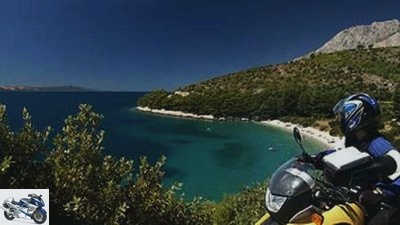
Iron ham
to travel
Motorcycle tour on the Dalmatian coast of Croatia
Motorbike tour on the Dalmatian coast
With mixed feelings
A civil war raged on the Dalmatian coast until the 1990s. Today it presents itself again as an ingenious area for motorcyclists – although many wounds are far from healed.
Sylvia Lischer
07/21/2006
There are hardly any cars coming my way behind Gracac. Gusts of wind sweep across the street, dust swirls up, the view sweeps over the basins and mountains. I’m on the way in the Krajina, the border area. Wide karst landscapes and a seemingly endless horizon characterize the area. Here and there a homestead can be made out, a small settlement – the Krajina is old, barren, self-sufficient farming land. Only when I slow down to ask for a gas station do I register that there are neither farmers, animals nor cultivated fields. And houses and stables are just ruins.
Until 1995 the war of independence raged against the unpopular Belgrade regime in the Croatian hinterland. Since the fronts of the former multi-ethnic state ran right through the middle of the population, shooting from house to house, from neighbor to neighbor, the uncle at the nephew. The traces of this tragedy do not motivate us to stop.
Refueling stop in Knin, then on via Drniš towards the Krka valley. It goes on, kilometer by kilometer, until the river valley appears behind Širitovci and the road leads downwards in many dodges. The barren karst landscape, marked by the civil war, disappears in the rear-view mirror, and immediately afterwards I stand on the banks of the Krka. Trees, bushes and flowering shrubs grow all around – the course of the 72 kilometer long river, which flows over countless cascades and seven waterfalls towards the Adriatic, leads through a botanical garden.
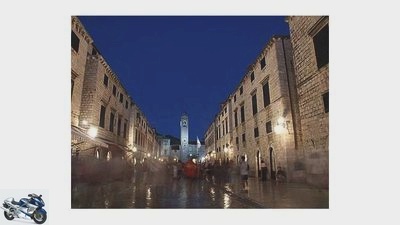
Iron ham
In the old town of Dubrovnik.
The road mutates into a slope, crosses the river and winds its way back up out of the gorge. Hoping to catch another glimpse of the natural paradise consisting of karst and water, I follow the course of the river south and get to the Krka National Park via Skradin. The deeply furrowed canyon landscape can be seen from a bird’s eye view from marked vantage points. Paths, bridges and boardwalks lead over the bottle-green river, which in this section has fanned out into many branches. Surrounded by ferns, mosses and wild flowers, I roam through the primeval alluvial forest to the Skradinski buk waterfall, take a boat trip to the Roški slap waterfall – and imagine myself behind every rocky promontory in the footsteps of Winnetou and Shatterhand, who were shooting in a canoe at the end of the sixties “In the Valley of the Dead” took the same course. A total of 13 Karl May novels were filmed in this part of Croatia at the time. It is already getting dark when I finish my national park trip and direct the BMW back to Skradin.
The place is characterized by winding streets, a marina, small pubs and fish restaurants. “Sobe?” I ask a bunch of children in the local language. And it sounds “Yes, room! Si, camere! Yes, room! ” return. The leader of the eloquent rascals grabbed me by the jacket sleeve and dragged me through the medieval scrub to a house, surrounded by vegetable patches, a chicken coop and date palms. An old woman appears, the toddler hands me a trophy and leaves with his entourage. The price negotiation with the exclusively Croatian-speaking grandma turns into a pantomime. I gesticulate, finally write “twelve euros” in the tomato patch and symbolically bring my hands to my mouth: “With breakfast?” Grandma nods, takes the money, shows me my room and disappears.
I go to “Agnella” for a beer in Jaminska Kušan, watch the old people play boccia and study the filled up bullet holes on the wall with “Smoke on the water” and “Radar Love”. Then I sink into the soft feathers of my night quarters between the lace doilies and framed family photos. When I take a look in the wardrobe and chest of drawers the next morning, I know why grandma disappeared so quickly the night before: she gave me her own room and looked for shelter with relatives. A lavish breakfast is ready for me in the living room, yesterday’s toddler storms past with his school bag, his mother greets me warmly in Croatian. It would be nice to find out more about the circumstances of my hosts – but how?
Croatia (2)
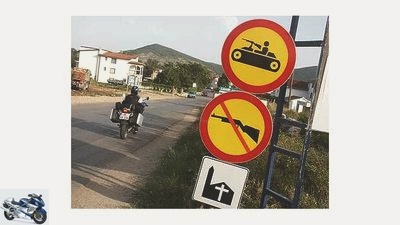
Iron ham
Tanks have to stay outside.
After breakfast, it’s off to the coast in the saddle of the BMW. A view of the old town of Šibenik is a must, if only because of the Krka, which flows here as a wide, almost fjord-like river into the Adriatic. Then the garden coast of Dalmatia welcomes me. Olive groves, orchards and vineyards that line the Adriatic in a hilly harmony. At Primošten the road meanders through sparse pine forests, bays with anchored sailing boats appear, vacationers in brightly colored Bermuda, campsites, holiday apartments.
Stopover at the “Kaos” cafe at the Trogir marina, where the Biokovo massif looms behind medieval buildings (approx. 12th century) and multi-million dollar yachts (approx. 1.2 million euros) in the east. Suntanned yacht owners stroll along the waterfront promenade with blondes wearing high heels, street performers juggle skittles, street vendors with corn on the cob over an open fire.
Two corners further is the old town of Split, which arose from a Roman imperial palace and is now a UNESCO World Heritage Site. Sterile museum atmosphere? Not at all. Almost every building, every pillar, every stone from history is lovingly integrated into everyday life. In the ancient inner courtyard of Diocletian’s imperial palace crowded street cafes; the youth of Split sit eating ice cream on Roman capitals; Fruit and vegetables pile up along the palace wall, and handicrafts in the catacombs. As in Diocletian’s time, life rages around the spacious imperial residence.
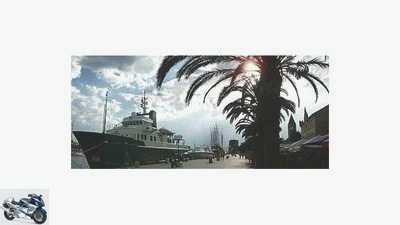
Iron ham
The wounds of the war have not yet healed.
I continue to the southeast, always along the coastal road, which is rightly one of the most beautiful routes in the world. The gentle, pine-covered hills recede behind Omiš, and rugged rock massifs towering well over 1000 meters take over the rule. The road winds its way along the steep coast in endless loops. On the right the islands of Bra`´c, Hvar, Pelješac and Kor`´cula, on the left the Biokovo mountains with the 1762 meter high Sveti Jure. In the summit region of Croatia’s third highest mountain there is a nature reserve with spectacular vantage points, which can be reached northeast of Makarska via a winding toll road. It winds higher and higher until, above 1500 meters, there is a kind of cockpit perspective over the cliffs, the Adriatic Sea and an archipelago counting more than a thousand and one islands.
Dusk is breaking when I come across the well-known forest of signs at the entrance to Makarska: “Sobe! Room! Room! Camere! Apartment! ”A blond toddler steers me in front of the motorcycle to my new night’s quarters. The lady of the house, Mrs. Rašic, greets me warmly and leads me – speaking fluent German – to a bedroom that – like my grandmother’s in Skradin – is furnished with family photos, clothes, linen and personal items.
I take the welcome drink with the family on the terrace, from there I catch a glimpse of a basement room crammed with beds and mattresses, in which the entire extended family has to sleep crammed together while I reside in the spacious bedroom. “First the war, then the post-war period …”, Ms. Rašic struggles for words almost apologetically, the family is just getting by. Nevertheless, she took in three war orphans, children of friends. She points to Zeljko, 24 years old. His parents were killed; he himself was captured by Serbians when he was 15. And Mateo, 16 years old, and his brother Goran, 13. The two still have six siblings scattered around the world, father and mother were shot. From Serbs? No, from Bosnian Muslims. Ms. Rašic looks at the ground, her eyes fill with tears, then she directs the subject to the weather report for tomorrow: bright, sunny, up to 29 degrees on the coast.
Croatia (info)
Croatia has long since established itself as a holiday destination again? thanks to a unique coastal landscape, fantastic island world, great beaches and attractive cities like Dubrovnik. However, the traces of the war are still present.
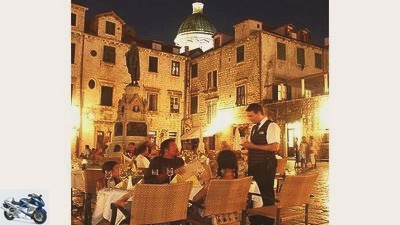
Iron ham
Dubrovnik lights up at night.
Getting there:
The main route through the Alps leads from Munich via Salzburg and Villach to Ljubljana. In addition to the Austrian motorway vignette, there are fees for the Tauern motorway and the Karawanken tunnel. Slovenia also charges tolls for the motorway. An alternative is to travel by car train from Hamburg, Dortmund or Frankfurt to Rijeka in Croatia. In the cheapest category, a motorcycle costs from 87 euros, for one person from 68 euros (single seat with five berths in one compartment). Information and booking by phone 01805/241224 and on the Internet at www.dbautozug.de.
Accommodation:
There is no shortage of hotels, guest houses and campsites of all categories in Croatia. If you want to stay overnight in a family atmosphere, look out for signs that read “Sobe” (private rooms).
The authors’ tips: Slavica and Nicola Rašic, Zagrebacka 100, Makarska, phone 00385/21/616555 or 612960. You pay 12.50 euros per person for the night, Ms. Rašic speaks perfect German. Tomislava and Ciro Ivkovic, Put Demunta 30, Trogir, phone 00385/21/881797. Here the night costs 17.50 euros per person, Ms. Ivkovic speaks English, Mr. Ivkovic German. Vera and Nicola Šišic, Andrije Hebranga 14, Dubrovnik, no phone. Mr and Mrs Šišic only speak Croatian – with five Croatian vocabulary and a little improvisation, however, you can get along very well. For an overnight stay near the old town you have to pay 17.50 euros per person.
Further information and information material is available from the Croatian National Tourist Board, phone 069/2385350, Internet: www.kroatien.hr. Information on Bosnia-Herzegovina can be obtained from the country’s embassy, phone 030/81471210, Internet: www.botschaft.bh.de. Attention: When traveling to Bosnia-Herzegovina, it is advisable not to leave the paved roads because of the risk of mines! There are detailed safety instructions on the Internet at www.auswaertiges-amt.de.

Map: Maucher
Zeitafuwand: one week; Route length 1000 kilometers.
Worth seeing:
The core zone of the 142 square kilometer Krka National Park can only be reached on foot or by boat. The waterfalls Skradinski buk and Roški slap and the island of Visovac are particularly beautiful. Information can be obtained from the National Park Administration in Šibenik, phone 00385/22/217720; Internet information: www.npkrka.hr. Several days should be reserved for a visit to Dubrovnik (UNESCO World Heritage Site). The huge city wall, on which you can walk around the entire old town, is particularly impressive. Diocletian’s Palace in Split (UNESCO World Heritage Site) is one of the best preserved monuments of Roman architecture and offers plenty of space for exploration.
The Old Bridge of Mostar in Bosnia-Herzegovina, which was re-inaugurated after restoration work in 2004, is about to be added to the UNESCO list of world cultural heritage and, together with the old town, is one of the top attractions in the region.
Money:
The Croatian currency is called the kuna (1 kuna = 100 lipa). For one euro you get around 7.3 kuna. The currency in neighboring Bosnia-Herzegovina is the convertible mark, whose exchange rate to the euro corresponds to the old German mark (1 euro = 1.95 convertible mark).
Literature:
You are well equipped with the 384-page vacation manual “Dalmatia and its islands” from Reise-Know-How-Verlag for 14.90 euros (with tips for trips to Bosnia-Herzegovina). The very practical gibberish volume No. 98 “Croatian word for word” for 7.90 euros comes from the same publisher. The general map “Croatian coast – center and south” on a scale of 1: 200000 from Mairs Geographischer Verlag is suitable for orientation. Price: 6.50 euros.
Related articles
-
Motorcycle trip on Croatia’s Adriatic coast
Iron ham to travel Motorcycle trip on Croatia’s Adriatic coast Motorcycle trip on Croatia’s Adriatic coast Fantastic coastal roads and island trips…
-
Motorcycle tour Dodecanese, Greece
Seitz to travel Motorcycle tour Dodecanese, Greece Motorcycle tour Dodecanese, Greece Wind-torn islands Secret dust slopes, volcanoes, sponge divers and…
-
Around Rijeka Croatia by motorcycle
Daams to travel Around Rijeka Croatia by motorcycle Out and about with a motorcycle in Croatia Sun, water, hot curves Some know it as a cheap holiday…
-
Out and about in Greece: motorcycle tour
Deleker 16 pictures Deleker 1/16 Dream beach: Porto Katsiki on the Ionian Sea. Deleker 2/16 At 600 years old, the Von Kipi Bridge is still young. Deleker…
-
Motorcycle trip along the North Sea coast
Daams 17th pictures Daams 1/17 Always in the sights of the two-wheeler captains: lighthouses in all colors, shapes and facets. Daams 2/17 South of the…
-
Motorcycle tour in Northern Thailand
Jo Deleker 36 pictures Deleker 1/36 Traveling by motorcycle in Northern Thailand. Deleker 2/36 Traveling by motorcycle in Northern Thailand. Deleker 3/36…
-
Motorcycle trip in Laos Report and tour tips
Jo Deleker 23 pictures Jo Deleker 1/23 Transport in Lao: In Pakbeng we load the Enduros onto a Mekong longboat. Jo Deleker 2/23 Curiosity, amazement,…
-
Motorcycle tour Himalaya Ladakh
Photo: Lohse 32 pictures Lohse 1/32 Lohse 2/32 … must not rely on perfect conditions. But a lot can be mastered on the Enfield. Lohse 3/32 Lohse 4/32…
-
Motorcycle tour Armenia – Ararat Caucasus
Jo Deleker 18th pictures Jo Deleker 1/18 Jo Deleker 2/18 The joy of the XT is infectious: the Yamahas provide fun in front of the Alaverdi prefabricated…
-
On the way: Enduro tour along the Turkish west coast
shepherd 23 pictures shepherd 1/23 When the little hunger comes: Gozleme fills the stomach magnificently. shepherd 2/23 Panorama wallpaper: Before…